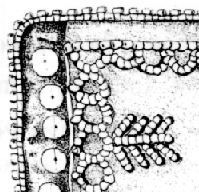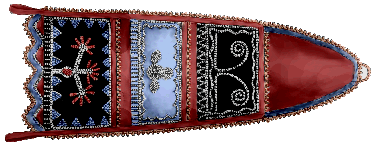

|
Many varieties of European glass beads were used by Natives of the 17th century. Among these varieties, tiny seed beads were sewn onto the clothing or accessories of Native Americans in New England. Van der Donck (1968), in 1656, described appliqueÇ work with beads of aboriginal manufacture such as pieces of whales' fins, whale bones, or wampum sewn onto leathern girdles, dressed deer-skin coats, and moccasins worn by both men and women, and he suggested also that these articles were 'bad to wear' for everyday use (Van der Donck: 1968).
The size of glass seed beads of the 17th century were only just slightly bigger than the head of a pin, but they are very large (and varying within a single 'lot' from 10/o to 8/o), bordering on 'Pony bead' size by today's standards. Common colors of seed beads in the 17th century are white, red, yellow, black, various hues of blue, and rarely colorless transparent beads. Nearly always the colors are opaque. The beads were strung onto necklaces, woven into bands and garters, and sewn onto clothing and accessories made from both leather and wool broadcloth using a variety of stitches. Beaded broadcloth items of the Northeast include long-coats, skirts, breech clouts, tunics, leggings, and caps throughout the 1800's and 1900's. Women of the Great Lakes region often appliqued the borders of skirts and leggings in white beaded double-curve designs.

|
Seneca [Morgan: 1993] |

|
[from Morgan: 1993] |
The beadwork of Mohegan center seam and pucker-toe moccasins, bags, and even beads sewn onto birch bark are described: "The beadwork figures are practically all floral, though a few geometrical designs occur; and realism appears as in the butterfly representation" (Speck 1915). Speck concludes that the same type of floral beadwork extends throughout the whole northeastern and Great Lakes area, and Speck believes may have been influenced by Victorian European designs.
Moccasins and other items of Northeast Natives may combine several techniques of beadwork including sewn applique and 'lane' stitch. Until recently American anthropologists and beadworkers referred to 'lane' stitch as 'lazy' stitch (coined by William Orchard in 1920's), or derogatorily, 'lazy squaw stitch' (so-called by Benjamin Hunt in the 1950's). "Among German beadworkers and Indian hobbyists this technique has always been known as 'Gassen-Stich' with 'Gasse' being one German translation for the English 'lane'"(Barth: 1993). Some varieties of Lane stitch lend a raised relief to the beadwork, producing a 3-dimensional effect, by making the width between stitches slightly closer together than the width of the row of beads. In addition, the unsewn edges of leather collars, cuffs, belts, etc. are often finished off with bead edging techniques.
New tools and supplies introduced by Europeans, like glass beads, metal needles and silk ribbon, were quickly incorporated into existing forms of art, and adjusted by Native Americans to suit their own aesthetic and functional purposes. With the development of new forms of art, traditional art forms were transformed or abandoned. Many of the same traditional designs are produced using bead and ribbon applique that were originally done with moose hair decoration, porcupine-quill embroidery and painted designs.
Contemporary Native Americans continue beadwork traditions today using glass beads. Some seed beads used today are so small you almost need a magnifying glass to see their holes. Bright light is always recommended for beadwork. Yellow and white can look very similar under dim light. A typical modern beadworkers toolkit will include the short stout Sharp's beading needles and the long flexible English beading needles. Nymo (nylon or polyester) beading thread with beeswax for a lubricant is now widely used (though waxed dental floss will do in a pinch). Scissors, a metal or bone awl with a triangular pointed tip, and needle nose pliers are also essential. Beading trays, containers, graph paper for designs, pens and colored pencils are also handy. A greater range of bead colors and shapes are available today, as well as special beading needles, synthetic threads and other accessories, but the images and dedication behind modern bead embroidery still have deep traditional roots.

|
Iroquois [Morgan: 1993] |
|
|

© 1994-1999 Tara Prindle.